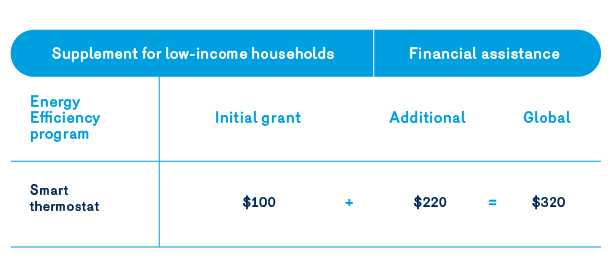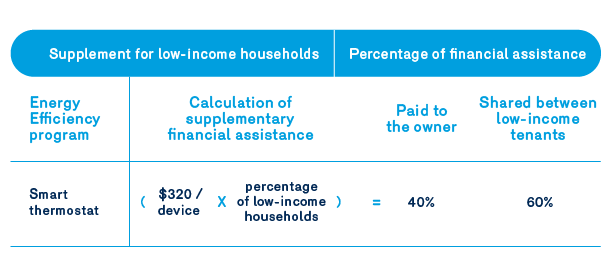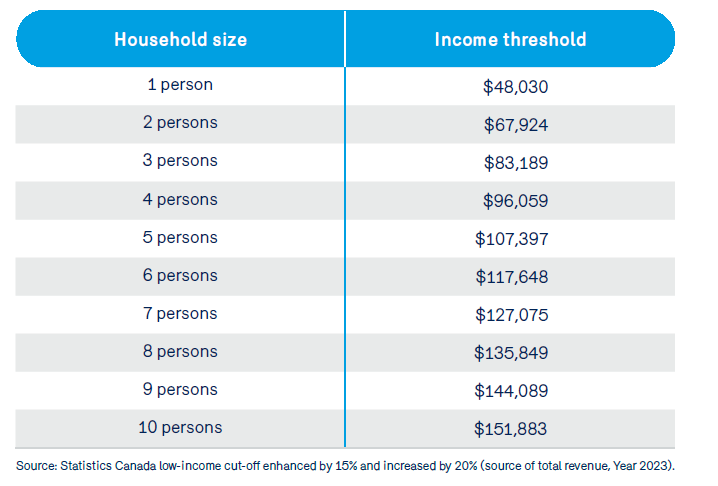Energy efficiency program – LIH support
Supplement for low-income households
We offer an additional grant to low-income households, in addition to the grant usually offered under the smart thermostat program.
Homeowners and renters can receive additional assistance to purchase a smart thermostat for their home.
Discover the benefits of the smart thermostat.
Grant – LIH support
Get an additionnal grant
Low-income owners
We are offering an additional $220 as part of the Smart Thermostat program.
Owner with low-income tenants
The supplementary amount is based on the energy efficiency program that you participate in. It also takes into account the percentage of low-income households living in the building. For example, if two low-income households live in a three-unit building, the basic financial assistance would be increased by 66%. This supplement is then divided between the owner of the building (40% of the supplement) and the low-income households living in the building (60% of the supplement).


The table below shows the different income thresholds by household size. To be considered a low-income household, family income must be equal to or less than the amount shown in the table.

Current or future Énergir customers who meet one of the following conditions:
- Be a low-income owner of a single-family home or condo.
- Be the owner of a condo, single-family home, duplex or triplex occupied by one or more low-income tenants.
You must participate in the residential smart thermostat program.
Note for Business customers: Owners of buildings with four or more units occupied by low-income tenants, as well as non-profits and housing co-ops can also benefit from the LIH program. Go to the Business page for the program.
Owner of a multi-unit property with one or more units occupied by a low-income household:
- The owner must first participate in an Énergir energy efficiency program.
- See the Participant’s Guide for eligibility criteria and any additional program information.
- Then submit your application to participate under Énergir’s Supplement – Low-income households (Form I) component before beginning work on the energy efficiency component you are participating in at [email protected].
- Énergir will send you an information document on the Supplement – Low-income households component to share with your tenants and a personalized letter inviting them to participate.
- Énergir receives applications from tenants and verifies their eligibility.
- Énergir issues a conditional confirmation of additional financial assistance to the owner.
- Complete the project and submit any documents required for the energy efficiency component.
- Énergir reviews the application and confirms the additional financial assistance to the owner.
- Énergir pays the additional financial assistance to the owner and low-income tenants.
Low-income owners
- The owner must first participate in an Énergir energy efficiency program.
- See the Participant’s Guide for eligibility criteria and any additional program information.
- Then submit your application to participate under Énergir’s Supplement – Low-income households (Form I) component before beginning work on the energy efficiency component you are participating in at [email protected].
- Énergir will send you instructions on how to qualify for the Supplement – Low-income households component.
- Mail a copy of the documents confirming your income to the Énergir agent.
- Upon receipt of the documents, Énergir verifies your eligibility.
- Énergir calculates the additional financial assistance you may receive once the work is completed.
- Complete the project and submit any documents required for the energy efficiency component.
- Énergir reviews the application and pays the financial assistance.
Conditions
1 The calculation presented assumes that all low-income households agree to participate in the program and provide proof of income. The amount awarded will depend on the number of low-income households participating at this stage.
2 You must complete and submit your application to participate (FORM I) before beginning work on the energy efficiency program you are participate in. The start of work is the date of signing of the first contract to carry out the project. Énergir reserves the right to:
- Modify or terminate the program without notice.
- Interpret the terms and conditions of the program.
- Limit the number of projects once the budget for the program is exhausted.